- Published: Tuesday, August 18 2015 19:18
The Galactic Visions Of Michael C. Turner
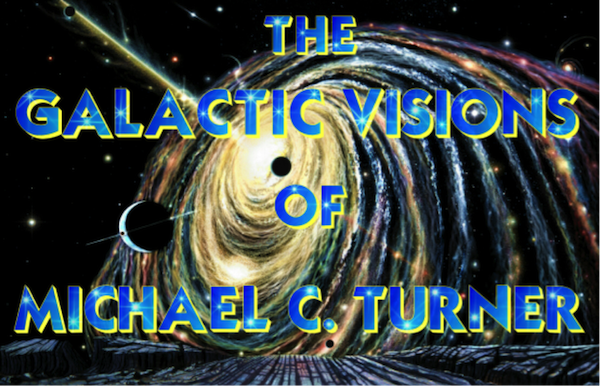
In my fist post I shared that my space art spans six decades. Actually the inspiration behind my art spans seven decades since I was born in 1952. My earliest recollections are of gazing at the starry sky and wondering just what those gently twinkling orbs of light actually were. I would imagine flying there on my own power, an early influence of the iconic Adventures of Superman starring George Reeves as the "strange visitor from another planet." Obviously this was an Earth-like planet, a kind of "Super-Earth!" During those early impressionable years I would often draw pictures of what I thought some of these distant world's might look like. These were fairly simple drawings and I rarely shared them with anyone or discussed my ideas about space.
I was fascinated by science phenomena, especially with anything that was extraordinary. It therefore isn't surprising that I devoured the science fiction and fantasy programs as well as the films of those early years. These ranged from animated programs such as Mighty Mouse and Astroboy to live action reruns of the Flash Gordon and Buck Rogers serials. Many of the classic science fiction films from that era and previous ones, such as "Forbidden Planet," "The Day The Earth Stood Still" and "The War of the Worlds" captured my attention and fueled my imagination.
All the while, my juvenile art was slowly developing toward it's ultimate destiny of spacescapes. This was well before the first scientific efforts to land on Earth's closest celestial neighbor, the Moon. In the beginning of the 1960s, the television media was rapidly becoming the most influential media across the planet. With the advancements in telecommunications and the first communications satellites, information access was increasing exponentially. The first practical electronic computers appeared on the scene which rocketed space exploration in a very literal sense. It was during the mid to late 1960s that my visions of space truly began to come in focus.
I was now copiously devoring scientific literature along with mind stretching science fiction. I was especially captivated by illustrations and paintings of space and, of course, the stars and potential planets that likely orbited them. One paticular space artist, Chesley Bonestell, had a powerful influence on me. I simply could not get enough of his wondrous art. Bonestell was a prolific artist and remains the most famous space art artist to this day. Among the science fiction genre's influence for me during the mid to later part of the 1960s was the now classic Star Trek which truly took my imagination and artistic mind to strange new worlds where no one had gone before . . .
Along with the more serious Star Trek was the whimsical Lost In Space with its iconic Robot warning "Danger, Danger" and defending the Space Family Robinsons from hostile alien life forms. Both Star Trek and Lost In Space provided an array of extrasolar star systems with habitable planets and fantastical life forms to seed the imagination off a young spacescape artist.
It was near the end of the 1960s that I created my first serious spacescapes. It was also the time of the first manned moon landing in 1969.
Everyone was expecting the Moon to have craggy mountians and deep canyons as depicted by early space artists. Chesley Bonestell's painitngs of the lunar surface had stirred my young imaginaiton. The first images transmitted from the Moon were rather dissapointing for me and many others who had expected the surface to resemble those early illustrations and paintings. Instead of majestic mountains and deep canyons, there were rounded mountians and hills with no signs of mysterious dark ravines or canyons. Nevertheless, the images did add to our scienitfic knowledge even if they did not stir our imaginations. In more recent years we have learned that the Moon harbors secrets that challenge us to return once agian to our nearest sibling companion in space to explore and evenutally to develop a lunar base.
Below are two of my early spacescapes from 1971 which are actually companion pieces, creating one scene. The images are from old photographs taken at different times under differnt lighting conditions and a bit of each has been cropped out so they don't perfectly match here.
 |
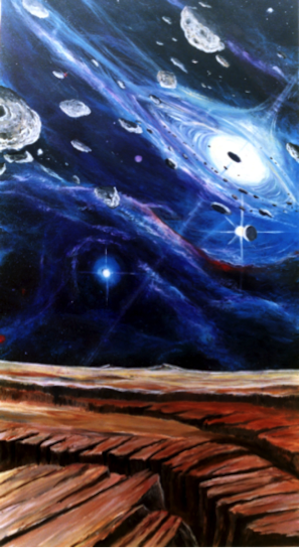 |
| "Lords of Light" | "Lords of Darkness" |
"Lords of Light ~ Lords of Darkness" Copyright 1971/2015-Michael C. Turner- Galactic Visions Space Art
Panel One
Lords of Light
Copyright 1981 Michael C. Turner ~ Galactic Visions Space Art
Acrylic on stretched canvas ~ 18x36"
(Panel one of two in the companion set, "Lords of Light ~ Lords of Darkness")
A hypothetical view from the surface of a moon of a ringed gas giant orbiting near a black hole (depicted in panel two, "Lords of Darkness). near the galactic center. The black hole is offstage to the right. Gaseous arms of once living star systems flow toward the "Dark Lord." Another moon of the gas giant eclipses one of the primary suns revealing the chromosphere. The planet's rings are composed of rocky debris, water ice crystals, and frozen gases. They orbit the planet in a plane perpendicular to the horizon as seen from the outer orbital moon.
* Black holes are believed to be in the galactic cneters of most galaxies. Are these perhaps the cosmic engines that fuel galactic recycling or perhpas the forces that keep galaxies in perpetual motion? Only time and further scientific investigation shall tell the truth. The truth shall most likely be more astounding than current theories of the cosmological engimas we call black holes, pulsars, and quasars.
Panel Two
Lords of Darkness
Copyright 1981 Michael C. Turner ~ Galactic Visions Space Art
Acrylic on stretched canvas ~ 18x36"
(Panel two of two in the companion set, "Lords of Light ~ Lords of Darkness")
A hypothetical black hole is depicted as seen from the surface of an outer orbital moon of a ringed gas giant planet (in panel one). Since a black hole can not be seen directly in visible light, it is depicted here as a black ovoid disk where light is not able to escape from the tremendous gravitational field of the black hole. It is only visible as a result of high matter-energy transformations as the black holes's gravity well pulls matter and energy beyond its even horizon into its inescapable singularity. The bursts of light and energy are the "death throws" of once living stars and other matter in the galaxy. The effects of the black hole on this planetary system are evident. One or more of its moons and planetary companions have disintergrated due to the high levels of gravitational influx fields. Eventually all the matter in this system shall be eagerly devourd by this "Dark Lord" for nothing, not even light traveling over 186,000 miles per second, is powerful enough to escape the gravitaitonal power of a black hole . . .
Below is another of my early spacescapes from 1971, "Waning Time - The Elder's Keep," and was part of a traveling art exhibition representing some of the most promising young artists of the early 1970s.

"Waning Time - The Elder's Keep" - Copyright 1971/2015 - Michael C. Turner - Galactic Visions Space Art
Waning Time ~ The Elder's Keep
Copyright 1971 Michael C. Turner ~ Galactic Visions Space Art
Acrylic on canvas panel ~ 24x20"
This haunting view of an ancient planetscape in a remote galaxy reveals an ancient world that is all but forgotten. Eon's ago this planet was geologically active. Now it stands silent, its volcanic mountains have waned away, leaving only jaged columns from what were once the firey throats of active volcanoes. An anciet lava channel recedes to the horizon as if it were some long forgotten pathway. A huge moon appears along the horizon, its surface scarred from ancient impacts of asteroids and meteoroids. In the hazy stellar background, masses of stars, gases and dust reveal that this planetary system orbits a star in an irregular spiral arm near the center of an ancient galaxy. What histories did such a world have? Did life ever exist on this now silent world? If so, was it life of higher intelligence? Did great civilzations develop and evenutally crumble back to the soil from whence they came? There seems to be no trace that any life ever existed here. If only the silent rocks could talk or the ancient glowing stars sing!
In 1971, I was awarded the senior art award of my high school for my impressionistic oil painting, "Distant World." Interestingly, the more realisitc painting I had originally intended to submit (Stellar Cathedral) in the competition was not used due to the advice of my art teacher. She told me that, although my space art was indeed my best work, that the judging committed would likely ignore it because space art was not a seriously recognized genre. I used another more traditional looking impressionistic oil painting ("Distant World") created with oils applied with palette knife on canvas panel. In my mind it would actually be an Earth-like extrasolar planet. I had to enter it as impressionistic landscape oil on canvas with palette knife. The judges interpreted the title to refer to the past in recognizition of traditonal impressionistic landscape paintings of the past. I alone knew it actually refered to a distant extrasolar world somwhere in the Cosmos. I regret to this day that I did not use my original intended spacescape painting even though it would likely have been ignored as my art teacher suggested. The only award I actually recieved for it was a certificat for, unfortunately, the art award was the only senior art award which did not also have a college scholarship to accompany it. In 1971 several of my spacescapes were selected as part of a North American/European traveling exhibition. They traveled throughout North America and all across Europe for several years but, alas, they were never returned to me. I often wonder if someday they might resurface after all these years.
Below, left, is the painting, "Distant World," for which I was awarded the senior art award in 1971 and to the right, "Stellar Cathedral," which I had originally intended to enter.
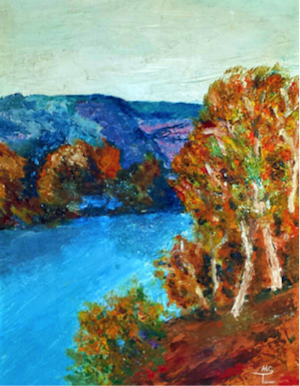 |
 |
| "Distant World" - Copyright 1971/2015 | "Stellar Cathedral" - Copyright 1971/2015 |
More of my early Galactic Visions spacescapes . . .
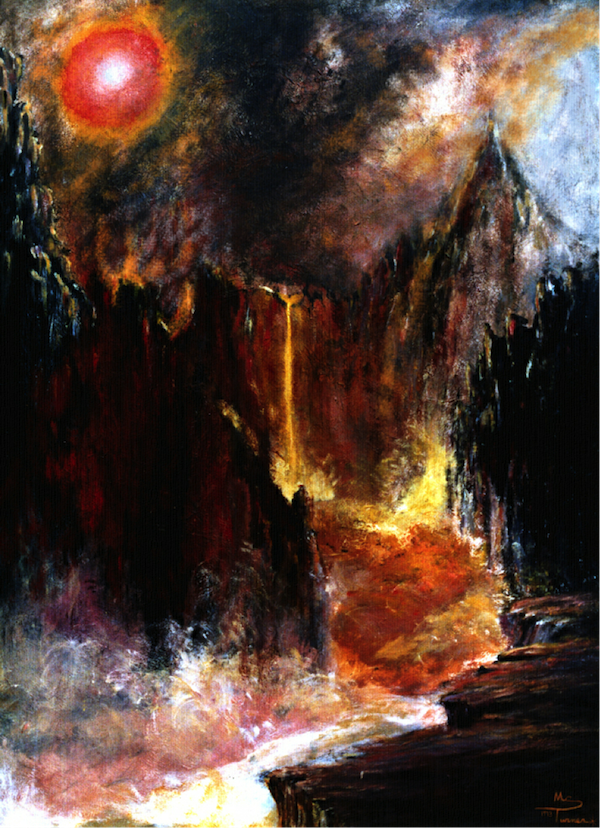
Vulcan's Retreat - Copyright 1973 /2015 - Michael C. Turner - Galactic Visions Space Art
Vulcan's Retreat" 36 x 60" ~ Copyright 1973 Michael C. Turner ~ Galactic Visions Space Art
An expressionistic view from a highly active volcanic planet with a Hades-like environment. The intent of this painting was to create drama with... the heavy use of paint and palette knife techniques. In such paintings, there is no attempt to create a realistic or photographic representation. Paint textures and colour techniques are utilized to create the desired atmosphere. This painting is much looser and devoid of the details that I currently employ with my paintings.
This is one of my early spacesape paintings from 1973. This was during my romantic expressionism stage using a palette knife on textured canvas. I received inspiration for this from one of Chesley Bonestell's paintings that appeared in the 1949 book titled "The Conquest of Space" which has some similar elements. He was an early inspiration for me and therefore, many of my paintings reflected this during the early 1970's. Of course, every artist should develop their own style and that usually evolves over time and, to some degree, is perpetual. I am considering revisiting this scene using my established style I developed over the decades. A comparison of my original from 1973 and now would be an interesting study.
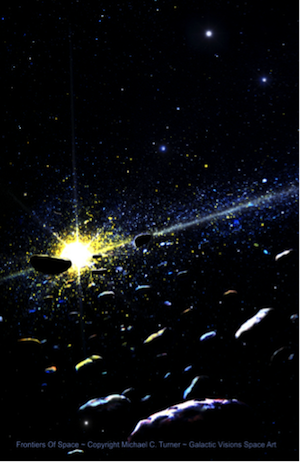
"Frontiers Of Space" - Copyright 1972/2015 - Michael C. Turner -Galactic Visions Space Art

Lord of Light ~ White Dispersion - Copyright 1977/2015 - Michael C. Turner - Galactic Visions Space Art
Lord of Light ~ White Dispersion
© 1977/2015 Michael C. Turner ~ Galactic Visions Space Art
Acrylic on stretched canvas ~ 24"X30"
A personal theory and interpretation of what might lie on "the other side" of a black hole. At the time that I created this painting (1977),black holes were a relatively new theory to the general public. I theorized then, and still maintain, that if black holes are a reality (and we know they are indeed real now), then there exists the possibility they are, perhaps, galactic devices for recycling energy and matter in the universe. Therefore, if a black hole is the absence of light and, if its gravitational field does pull anything into it that passes beyond its event horizon, is it not equally probable that it simply is "transporting" matter in the form of energy to some other point in the universe and possibly in time as well as dimensionally? Admittedly, this is highly speculative however, isn't that where all true science begins and, in the end, is not the truth often more astounding than theory? In this painting, I have depicted a "white dispersion" as a tremendous outburst of light and energy. The rocky matter is not being transported intact from a black hole through the dispersion but is rapidly forming as energy levels decrease, permitting the transformation of energy into matter. As some energy transforms into solid material, the higher energy outbursts cause collisions of previously formed matter. These "explosions" of energy might come at irregular intervals depending upon the activity of the white dispersion's counterpart, a black hole. The rocky debris that appears to be radiating from the center of the white dispersion is in reality older material that has clumped together and is being bombarded by a recent energy outburst. If black holes/worm holes are passageways to other universes and times or "subways" within our own universe then matter itself apparently cannot make that journey, it must cast off the old nature of the physical and take on a new nature of energy. If this seems metaphysical or spiritual then perhaps there is more to ancient religions than just "faith!" However, since energy and matter are neither created or destroyed, according to presently accepted laws of astrophysics, we can understand these matter/energy transformations in relatively simple terms even if we disregard any metaphysical concepts.
In my next post, I shall share more of my vintage spacescape paintings along with my thoughts about them and the Cosmos.
May all your visions be "Galactic Visions...
~ Michael C. Turner ~








Comments